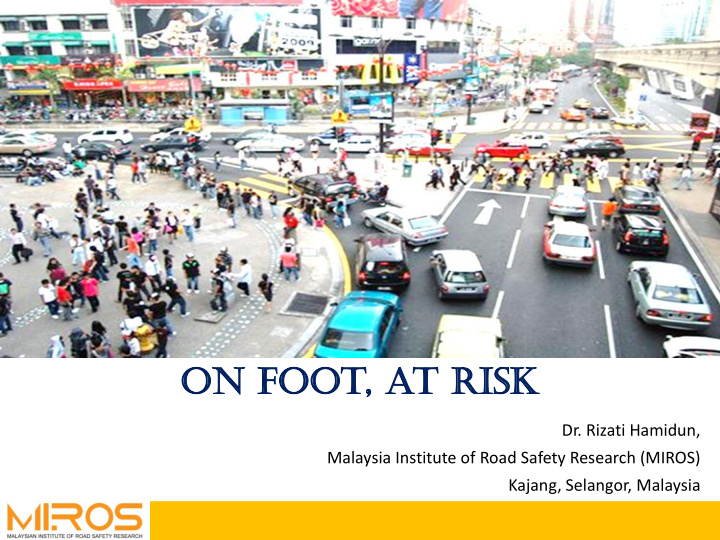



on foo oot, , at ri risk Dr. Rizati Hamidun, Malaysia Institute of Road Safety Research (MIROS) Kajang, Selangor, Malaysia
RIS ISK FACTORS CONTRIBUTE TO PEDESTRIAN CRASH Source: Zegeer & Bushell (2011)
RISK 1. WHAT? 5. HOW? 2.WHO? CRASH RISK 4.WHERE? 3. WHEN?
WHAT?
WHAT? INJURY RISK = probability/threat of damage, loss, injury or any negative impact RISK OF VRU CRASH FATALITY
PEDESTRIAN CRASH • Every year, about 1.35 million people died resulted from road crashes and between 20-50 million suffer non-fatal injuries (WHO, 2018) • More than half of all road deaths are among vulnerable road users: pedestrians, cyclists & motorcyclists • More than 270,000 pedestrian killed Source: Naci et al. (2009) every year and constitute of 22% of the world road crashes deaths (WHO, 2013). • Pedestrian have a higher risk of death per kilometre travelled and become a large portion of road victims in low income and middle income country (WHO, 2013).
PEDESTRIAN CRASH IN MALAYSIA ❑ The fatality rate of pedestrians in Malaysia is the third highest after motorcyclists and car drivers 5277 pedestrians died in 10 years Source: PDRM, 2017
WHO?
WHO? WHO AT RISK? Those who travel on foot; • pedestrian • wheelchair • skateboard • bicyclist
WHO? Vulnerability of those travel on foot • Higher risk of fatality & injury when involved in a road crash • Those who are not protected by metal body (vehicle) Source: Wramborg, 2005
PEDESTRIAN BEHAVIOUR Reasons for the majority of pedestrian casualties are careless crossing and Pedestrian Casualties By Movement Behaviour walking/playing on carriageway: ❑ Disobey traffic light Infirmity 27 ❑ Jaywalking Not Using Pedestrian Crosing 17 ❑ Dash out Intoxication 7 ❑ Misjudgement of speed or gap Drugs 0 ❑ No/improper facility provided Careless Crossing 586 Handicapped 2 Jogging 2 Walking/Playing on carriegeway 394 0 100 200 300 400 500 600 700 Total Casualties Source: PDRM, 2015
BEHAVIOUR: Jaywalking Pedestrian • Crossing outside of crosswalk or jaywalking is technically violating spatial crossing compliance • Jaywalk is unexpected situation to drivers that affecting driving judgement through shortening their reaction time (Zheng et al. 2015). • Lack of supervision of children • Reasons of jaywalk? • Longer walking distance to the provided facility • Save time • Presence of bus stop • Norm
BEHAVIOUR: Drivers disrespect & violation • Running red light – high approaching speed/dilemma zone • Vehicles stop at crosswalk • Not slow down/giving way for pedestrian • Driver distractions • Unsafe driving practices
WHEN?
WHEN? RISK WHEN THEY CROSS THE ROAD • • OFF ROAD ON ROAD
RISK ON ROAD
PROVISION OF PEDESTRIAN FACILITIES ISSUES: • Inappropriate location of facility • No channelization: by fencing, walkway • Unclear ROW • Lack of speed control • Not consider special need: children/wheelchair/blind • Lack of pedestrian footpath • Improper crossing facility: Signs & road markings
WHERE?
WHERE? At location with HIGH NUMBER of CROSSING PEDESTRIANS • School Area • Shopping Area • Public Transit
WHERE? HIGH RISK CROSSING ON ROAD WITH FOLLOWING CHARACTERISTICS; • High volume of vehicles • High vehicle speed • High volume of HV • Wider road, high number of lanes • Absence of traffic control – traffic light • No/lack provision of pedestrian facilities • Poor lighting – low visibility of pedestrians
HOW?
HOW? HOW IT HAPPEN? When pedestrians meet vehicle at the SAME TIME & SAME PLACE SAME TIME + DIFFERENT PLACE = NO CRASH DIFFERENT TIME + SAME PLACE = NO CRASH
HOW?
IMPACT OF COLLISION Momentum = mass (m) x velocity (v) • the sum of the momentum of the two objects before the collision is equal to the sum of the momentum of the two objects after the collision After Crash Before Crash mv car + mv ped = mv car + mv ped Car stop, mv car = 0 Pedestrian hit car, thrown & hit ground, mv ped increase
IMPACT OF COLLISION Momentum = mass (m) x velocity (v) After Crash Before Crash mv car + mv ped = mv car + mv ped Higher m car = increase severity Higher v car = increase severity
IMPACT OF COLLISION Human body tolerance to impact is limited and severity influenced by: • Impact speed • Type of vehicle • Stiffness & shape of vehicle • Parts of body • Different age group • Height of pedestrian • Standing position Source: Yang,2002
IMPACT OF SPEED HIGH SPEED = HIGH IMPACT 27
IMPACT OF MASS BIG MASS = BIG IMPACT vs Van/car/motorcycle Heavy Vehicle 5.6 times fatality risk Source: Hamidun(2017)
PREVENTION?
CONSIDER YOU AS PEDESTRIAN We as pedestrians, NOT them as pedestrian What if..i’m a child What if..I’m old What if..I’m blind What if..I’m on wheelchair
CONSIDER YOU AS PEDESTRIAN • What is the best/safe way to cross.. • How to protect yourself from being hit by vehicle… sign Pedestrian linked bridge Pedestrian signal walkway Zebra crossing
Presented by : FOR YOUR ATTENTION Dr. Rizati Hamidun Research Officer Road Safety Engineering and Environment Research Centre, Malaysia Institute of Road Safety Research (MIROS), Presented by : Kajang, Selangor, Dr. Rizati Malaysia Hamidun LOT 135, JALAN TKS 1 www.miros.gov.my TAMAN KAJANG SENTRAL 43000 KAJANG, SELANGOR +603-8924 9200 MALAYSIA
Recommend
More recommend